
The start point for the best source of fleet information |
Final report: Mitsubishi Outlander PHEV long-term test
Date: 27 August 2019 | Author: Rachel Boagey
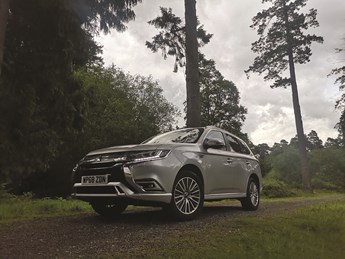
|
|
||||||||||||
Last report - Bye bye battery
The time has come for me to hand back the keys to my Outlander PHEV. I must admit that, in the last few weeks, I was beginning to look forward to my replacement diesel test car, but as I saw the driver collecting the Mitsubishi heading off into the distance, I couldn't help but feel a hint of sadness that my time with the plug-in workhorse was over.
It was my first time driving a plug-in hybrid on a long-term basis and although I sometimes resented the Outlander, custodianship of the car was somewhat of a learning curve - but in a
good way.
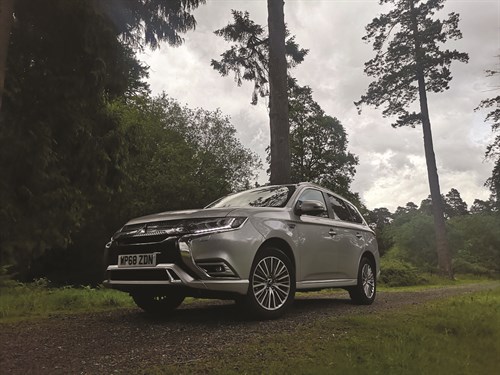
Yes, it took a while to get used to its limited electric range and to learn how to drive it to the optimum settings for maximum power, and yes, the Outlander has its flaws (which I have mentioned in previous tests). One of the main drawbacks is its price, and I have to say I was a little baffled when I first learned this 4h equipment level car sits just below the £40k mark, but lacks much of the kit you would expect for that money, including a sat-nav, of course, (no, I am not over that yet). In the lower trims the current car starts at £32k, rising to just under £44k for a fully specced 5hs, but we expect the equipment level we had to account for the majority of sales.
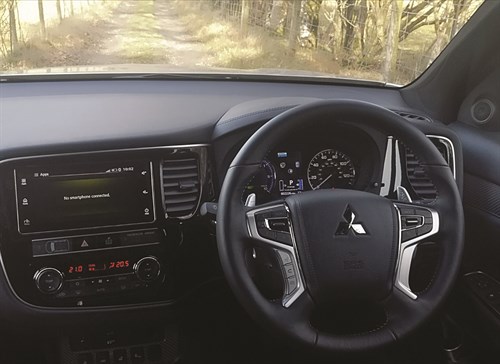
All that said, the Outlander PHEV has many perks. It proved itself very useful for long road trips, with its large boot, flat-folding rear seats and, of course, its ability to do the last few miles around town and in the city on pure electric mode. Despite its size, the Outlander is easy and relatively pleasant to drive. Refinement is good at low speeds, especially when the electric motors are in action. The 2.4-litre engine is also quiet and refined, only becoming strangely audible under heavy acceleration or when going uphill.
Inside, the Outlander, while very basic in the tech department, is a pleasant place to be for drivers and passengers, with plenty of room - storage room is ample too.
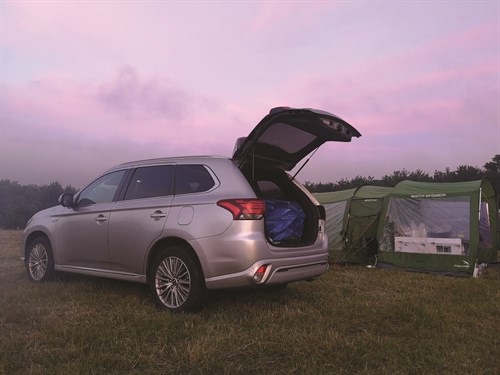
In reality, if you are thinking about a PHEV, you are probably looking to minimise your tax liability, a very valid reason to consider this Outlander plug-in; it will be cheap to run, too. No, you probably won't get 159.5mpg, (unless your commute can be done almost entirely on electric power), but even with the heavy battery the Outlander nonetheless promises decent fuel economy overall if you charge it regularly.
And of course, CO2 emissions of 46g/km under the WLTP (on the old NEDC cycle it is rated at just 40g/km) means your tax bill will be tiny. We are talking thousands less per year than an equivalent petrol or diesel.
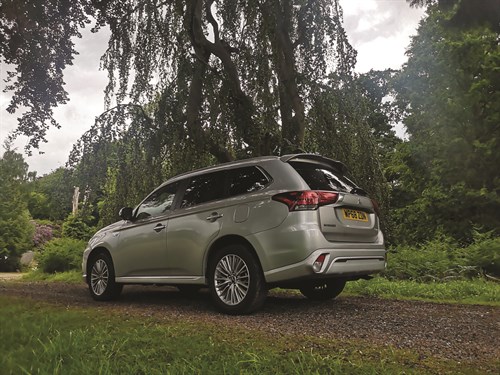
As I jumped into my diesel long-termer for the first time and realised I won't be able to get anywhere near the mpg I achieved in my Outlander PHEV, I began to question when a viable diesel plug-in would be available on the market. For this reason, it is hard not to recommend the Outlander in many ways, because it is the only car of its kind that really exists - an 'affordable' large SUV with sub-50g/km CO2 emissions.
If you are a business user with a couple of kids, you might struggle to fit them in a 3 Series or similar, and because the tax savings are so massive you really ought to have a PHEV. So, if it fits your lifestyle, the Outlander really is the only option.
Update 6 - Breaking the stereotype
In a previous review of the Outlander I wrote about how I was able to drive it into the city centre to test out the manoeuvrability of the chunky SUV.
While it performed well in the city streets despite its size, being a 4x4 the Outlander's capabilities should really lend it to bigger, more challenging roads.
What becomes obvious after driving the Outlander on the motorway is that Mitsubishi has worked hard to make it drive more like an SUV than some of the more authentic 4x4s we've become used to driving.
That is not to say that the Outlander is perfect, though. Revised front and rear shock absorbers are supposed to make the ride a little smoother, which they do, but it is still not the smoothest-driving SUV. Speed humps are to be approached with caution unless you want a bit of a bump in the bum department, but body control is quite impressive, helped, no doubt, by the weight of the battery low down.
There are a few driving modes to get your head around in the cabin, such as an EV button that stops the engine from kicking in if you want to remain in electric mode (provided there's enough charge). Then there is a sport mode that sharpens the throttle response but it is pretty much pointless, as preserving battery life is the aim of the Outlander game.
Speaking of which, the Eco button does the exact opposite, making the throttle less sharp in order to preserve electricity.
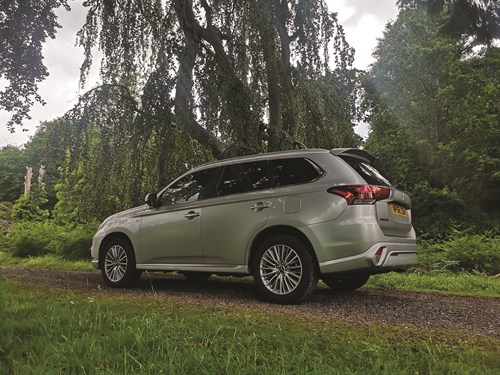
Then we get to the AWD system, which gives the powertrain a further three modes - normal, save and charge. The save option keeps the battery topped up if, like me, you live in Zone 2 and want to get home without roaring around the tiny streets of south London in the loud ICE engine. Charge does what it says on the tin and charges the batteries if you aren't heading to a location where you can easily plug in. This mode in particular is able to recuperate charge quite quickly if you are driving at speed, and is therefore one I use a lot while motorway driving.
It is worth noting that none of these modes are automatic and you have to remember to click them on yourself, but it is funny how quickly you remember to whack charge on when you are trundling down the M4 and can see the battery power disappearing before your eyes. But it is also worth mentioning that there are six levels of regenerative braking, which it took me at least two months to discover. They are operated by moving the gear selector from D to B and playing with the paddles behind the steering wheel, which in D fulfil their normal purpose of allowing you to change up and down gears before the transmission does it automatically. It is worth noting that the paddles are weirdly labelled + and -, but they do the opposite of what you would expect. Once you get used to using the regenerative mode, it is likely you will use it all the time.
It may have its flaws, but if you are after a PHEV SUV that drives well, yet is cheaper than similar offerings from German manufacturers, then you are in for a treat. However, at 40k, we will be revisiting whether or not it is worth the money in our next, and sadly final,
long-term report on the Outlander.
Update 5 - What do you mean there's no sat-nav?
Using Android Auto isn't something I would usually groan about; in fact, it's often my go-to as I trust its reliability and live traffic information. But in all honesty, I have come to expect most new cars to have their own built-in sat-nav, and it came as a bit of a shock to me
when I discovered my long-term Outlander doesn't.
Not only is a built-in sat-nav important as a back-up when you run out of 4G driving out in the sticks, it would have also been very helpful during the process of moving flats last week, since the wi-fi at home took a good few days to get set up.
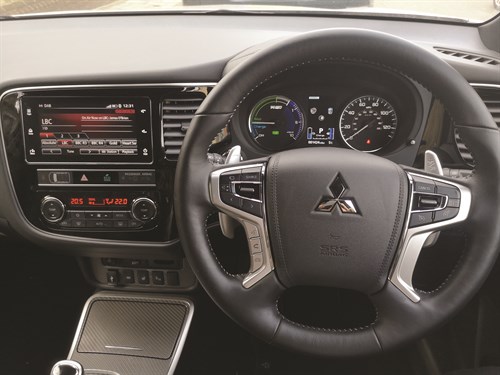
I resorted to tethering my laptop to my Huawei internet one morning before a conference, only to then find my usually long-lasting phone internet had taken a beating and was now going to cost a fortune per MB before my renewal date. This meant that jumping into my Mitsubishi and plugging in my phone was an expensive option. Instead of paying, I decided to try and remember my way into Canary Wharf, having driven there a few times before. A trip to Leeds, where I definitely wouldn't be able to find my way, ended up costing me around £20 in extra phone data for Google Maps. It is safe to say I will be requesting a sat-nav in my next test car.
Another complaint has arisen during my time with the Outlander. The screen that displays the radio (and Android Auto) isn't the best quality display and in all honesty looks something out of the early noughties. To the right of the screen, the closest buttons to the driver are those to control the volume of the radio and to turn the display off, not to change the display menu or operate the radio, meaning I have to reach right across to the passenger's side if I want to do any of those things while driving - which isn't too easy a task.
Update 4 - Trying for size
If you are considering the Outlander for its potential use as a family car you may already know that the biggest difference between the PHEV and the conventional Mitsubishi Outlander is the lack of a seven-seat option, due to the extra space taken up by the batteries. But before you rule it out of your choice list, you should know that boot space in the hybrid Outlander due to the batteries drops by just 14 litres, meaning the PHEV still has an adequate 463 litres of luggage room. Pretty good, right?
A bank holiday weekend road trip from London to a caravan site in west Wales with lots of luggage, bedding and two adult bikes seemed like a great opportunity to see whether the boot size and space is sacrificed too much due to the placement of the batteries.
You should also know that due those very same batteries, the boot floor is quite high compared to other SUVs of its size, which means it is quite shallow, and while you can get a couple of large suitcases in you can't really put anything else on top if you want to pull the load cover across to hide them. Also it is worth noting that there is no room for a spare wheel - you have to make do with tyre-repair foam instead.
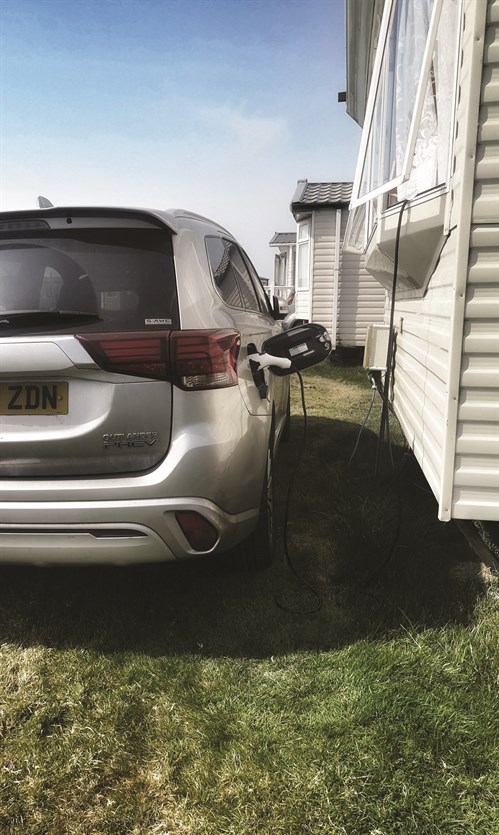
When trying to pack the boot like a game of Jenga, what we found was that the lip-free opening makes loading heavy stuff such as bikes really easy, and also means you can lift your suitcases up and simply slide them across the floor to the back. What we also found, though, was that we were nowhere near fitting two adult bikes in the boot unless we folded the rear seats down. Luckily, there are only two of us, and the extra room gained from folding the rear seats 60:40 was plenty to accommodate all of our luggage - and the kitchen sink, if we so wished.
The wheelarches intrude somewhat, but there is a nicely sized cubby under the boot floor for stashing the charging cable and some neat touches, including a couple of deep pockets on either side of the boot that proved useful for drinks bottles and things that would otherwise roll around, and there are four tie-down hooks too.
Overall, the boot in the Mitsubishi coped very well with some luggage, but it was necessary on this occasion to make use of the extra room available in the car with the rear seats folded. Unfortunately, needing to make use of this extra room meant turning down a friend who wanted to hitch a lift back to London. Perhaps it is time to invest in a roof rack.
Update 3 - Party tricks
An awards ceremony in the centre of London meant I recently got to show off some of the Mitsubishi Outlander PHEV's party tricks. Of course, I don't mean its 4x4 abilities, although testing those outside of the city has been good fun. What I am referring to is certain qualities this large car has that you may not necessarily expect from looking at it, qualities which I feel wouldn't be taken for granted by business drivers.
Firstly, I was able to carry my outfit for the evening and my work gear for the next day straight from my flat into the car in the pouring rain, and when I fetched it out at the hotel there wasn't a crease or watermark in sight. Of course, I could have driven any car into the centre of London, but I usually wouldn't even consider it. The reason I chose to drive in is because this car is exempt from the capital's congestion charging zone due to its PHEV powertrain - not to mention it being registered before a particular date, meaning I basically own a get out of tube free card. Score!
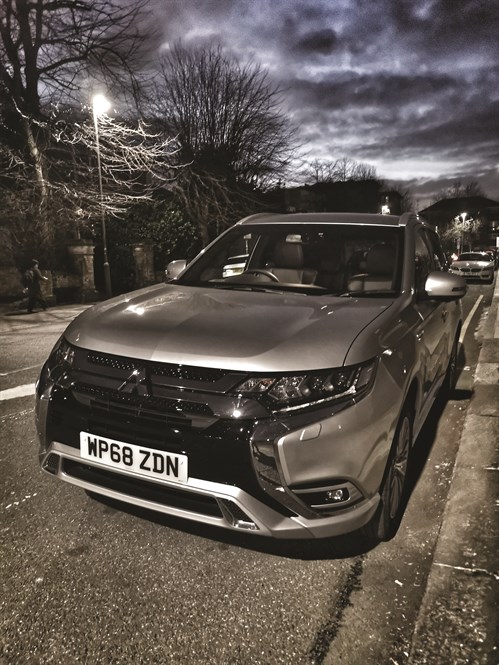
Another of its party tricks also became apparent when navigating through the tight, traffic-packed streets of central London. Despite being a big 4x4, the Outlander is extremely easy, even effortless, to drive. It is automatic and the steering is well weighted, and because it is electric, you get instant and smooth take-up when moving off - which is always handy when stopped in front of other moody, impatient London drivers at traffic lights.
It is not just driving but parking that is made simple with the parking sensors, the rear camera, and even a button on the steering wheel you can press that shows the view in front of the car and an aerial view of the vehicle. Parking in a tight underground hotel car park was easy, and the visibility benefits of being high up are appreciated. There is also the ability to unlock the car by pressing a button under the door handle if the key isn't in your hand - i.e. when it was at the bottom of my handbag and my hands were completely full of other things. Thankfully, Business Car's custodianship of the Outlander ensured Cinderella did go to the ball.
Update 2: The big green petrol machine
With an official range of around 28 miles, it is quite easy to begin to question whether there is enough electric range available in the Outlander PHEV to make any sense in the real world.
Don't get me wrong; if like me you use the car purely for short hops to the supermarket and a 40-mile trip to the office, during which you barely dip into the petrol and religiously charge it up in-between, you will wonder why you didn't have a PHEV before. Those situations are when the Outlander PHEV definitely makes sense.
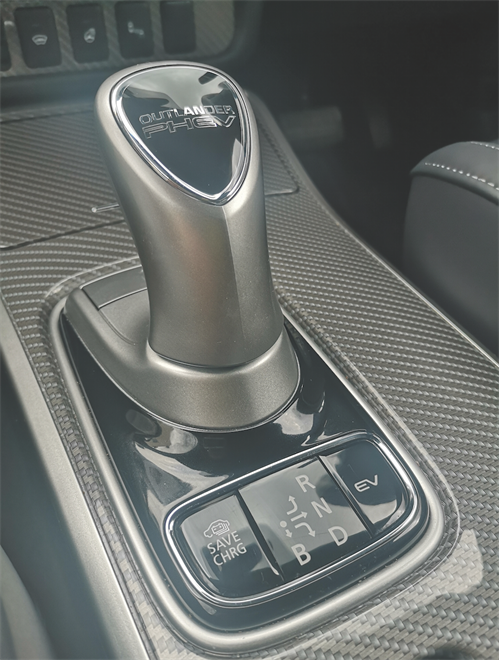
The doubts emerge when you want to go any further than that. On its current mileage of 2,120, its electric-only range has varied between 12 and 27 miles, depending heavily on the weather, might I add. I used it for an evening drive home from the office on a very cold Thursday and barely ten miles into the M25 stretch of the commute my eyes were diverted to the almost empty gauge after a full charge was completed just half an hour before.
It is times like these on long motorway slogs when the electric drains very quickly when driving fast and so does the petrol in the 2.4-litre tank, meaning lots of stops at motorway service stations. You know exactly when the switch to petrol happens too, as the turbocharged engine suddenly (and loudly) roars to life. On its newly rated WLTP cycle statistics, the Outlander PHEV emits around 40g/km on a combined cycle, which is surprisingly low and has also been quite accurate so far on average when running on mostly electric.
I have recently adopted the habit of pushing the 'save' and 'charge' button to see how much electric I can regenerate while driving on petrol. This activates series hybrid mode, where the engine runs to charge the battery providing power to the wheels. It doesn't seem to have had too much of an effect on the mpg of the petrol engine so far, and it is still averaging 38mpg, even with this mode activated almost every time I have a full tank of petrol.
I'll look forward to seeing how the mpg changes when I do longer motorway runs on petrol alone.
First report: Great all-rounder?
It is easy to forget that Mitsubishi pioneered an electric car long before it was fashionable and it subsequently added a plug to its family SUV, providing an electric option with its biggest seller.
And there is a lot to like about the Mitsubishi Outlander PHEV, which is why we were more than happy to welcome it onto the Business Car fleet recently, and I was happy to be the one plugging an electric car into my motoring journo lifestyle.
With the onset of winter and talk of snow on the weather forecast (even down south), I am rather excited to have four-wheel drive, and I am also interested in experiencing the promise of guilt-free short drives and managing charging on longer ones.
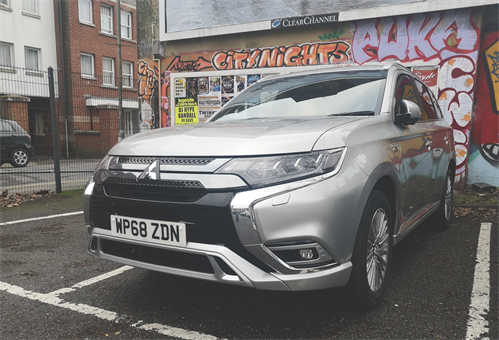
The Outlander PHEV's big selling point of course is its hybrid powertrain and a lot has changed in this latest version. Where there was once a 2.0-litre petrol engine, now there is a 2.4-litre unit. The rear electric motor, the battery and the generator are all stronger, and the software that integrates all of this has been updated too. These updates mean the car is closer to the expectations of businesses who want to do their bit in helping the environment, not to mention save themselves some pennies due to its exemption from the London Congestion Charge and very low rates of company car tax - how long this will last remains to be seen, however.
"The rear electric motor, the battery and the generator are all stronger."
This Outlander holds enough charge to drive for around 28 miles with zero emissions. So far we have found that the best way to make the most of the battery economy is around town, where you can spend almost the whole time whizzing around without even rousing the petrol engine. On first impressions, and doing a couple of drives back and forth to the airport, it is clear that the electric engine quickly falls flat at high speeds, not to mention cool temperatures. Luckily, when the battery is depleted or you just want to go further, the petrol engine kicks in to save the day.
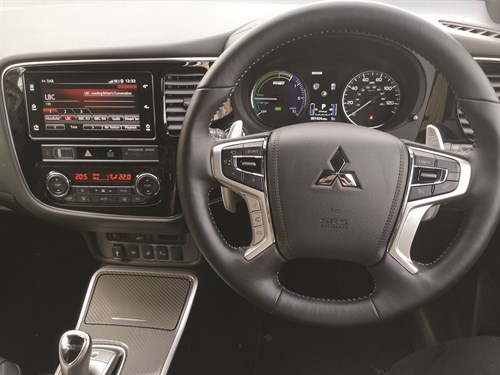
The boot is a decent size, albeit not as big as you would get in the Skoda Kodiaq. The reason for this is that the rear of the car houses the batteries and electric motor, resulting in around 25% less capacity. We will do a few more airport runs over the next few months in order to decide whether this is really a problem worth sacrificing a hybrid engine to solve, though.
The question I'm really looking to answer in my six-month custodianship of this car is whether the petrol-electric hybrid bit of the equation makes any sense in the real world, and ultimately if we'd recommend putting one of these onto your fleet. Watch this space.
Mitsubishi Outlander PHEV 4h 2.4-litre petrol hybrid auto 4WD
P11D price £39,445
As tested £39,995
Official consumption 159.5mpg
Our average consumption 134mpg
Final mileage 7,987










